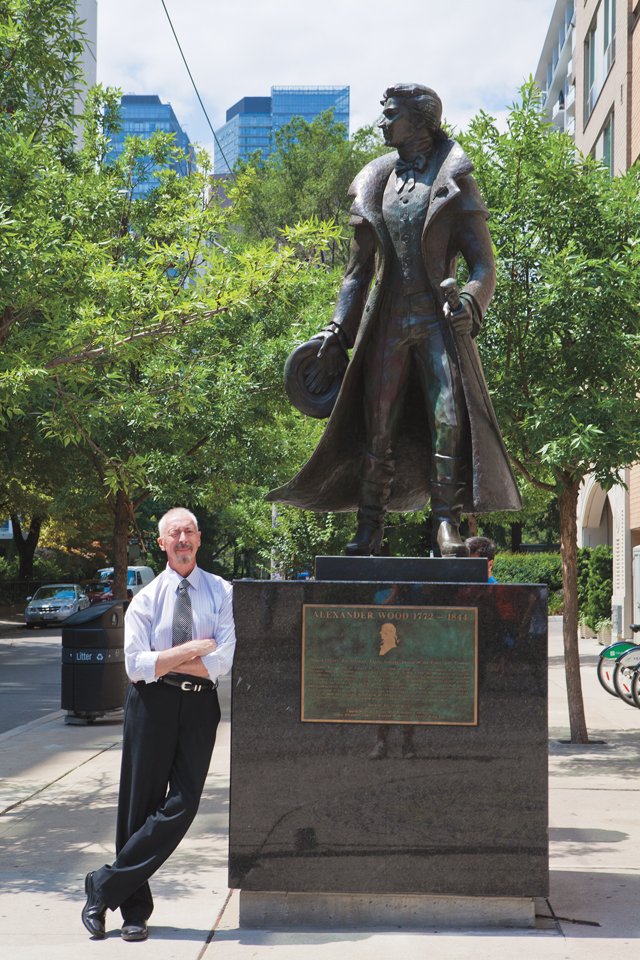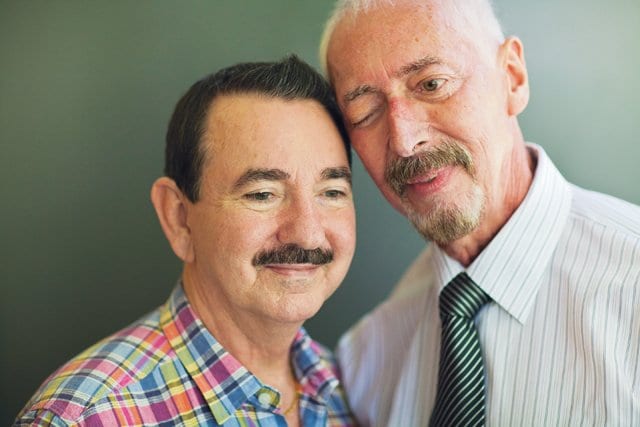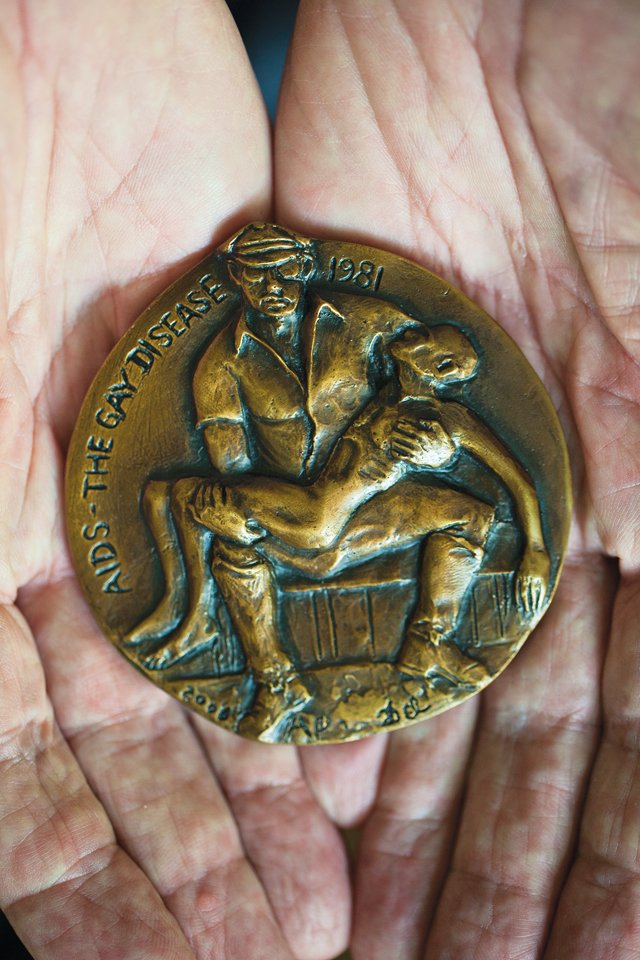
Newbigging poses with his statue of Alexander Wood at Church and Alexander streets. Credit: Adam Coish

Newbigging with John, his partner of 32 years. Credit: Adam Coish

An example of Newbigging's work. Credit: Adam Coish
Aug 28 — Del Newbigging died with family at his bedside at Toronto’s Princess Margaret Hospital on Aug 23 after a battle with cancer.
Cremation has taken place. A celebration of Newbigging’s life will be held at the Mount Pleasant Visitation Centre on Saturday, Sept 29 at 1pm, on what would have been his 78th birthday.
. . .
Aug 9, 2012: The best artist has that thought alone, Which is contained within the marble shell; The sculptor’s hand can only break the spell To free the figures slumbering in the stone – Michelangelo
Life is a little like sculpture. We chip away at its surface, hoping to leave an indelible mark that will give testimony to our little moments of existence, to show future generations that we lived, with the hope that our contributions will somehow persevere long after we’ve passed from memory.
Del Newbigging has spent his life making such marks, both metaphorically and literally. In a city where public art is, at best, acknowledged with a distracted nod or the occasional tourist photo op, Newbigging’s most recent statue was unveiled to a rapturous crowd of hundreds and a flood of media fanfare that spread from Toronto clear across to the United Kingdom.
The piece in question was, of course, the statue of Alexander Wood that now stands proudly at the corner of Church and Maitland streets. Cast in solid bronze with a beautiful green patina, Newbigging’s tribute to one of Toronto’s earliest (purportedly) gay men is that rarity of urban sculpture: classic, accessible and aesthetically pleasing. Its lifelike, intricate detail stands apart from the more freeform modern pieces that dot our city’s landscape, leaving no question that it was sculpted at the height of its creator’s artistic powers.
“We’re not sure what he looked like,” says Newbigging, whose only historical source was an antique silhouette of Alexander Wood. “I picked up his bow tie and ponytail from his silhouette, and from the silhouette I could see that he had a flower in his lapel. He was a dandy.”
Newbigging also added personal touches to his creation, including a nod to another famous Canadian dandy. “On my Alexander Wood the flower is a rose, and that’s my tribute to Pierre Elliott Trudeau and all the good he did for gay people.”
In another cheeky move, Newbigging used his husband John’s derriere as a model for the plaque illustrating Wood’s notorious inspections on the statue’s base. It’s become somewhat of a lucky charm for passersby, whose penchant for rubbing the rounded globes have left the sumptuous cheeks smooth and bright. “You rub them before a date so you get lucky,” Newbigging chuckles.
That the statue stands at all is a tribute to both Newbigging and the team that championed its creation. It took the combined efforts of then-BIA members Kristyn Wong-Tam, Dennis O’Connor and Brandon Matheson to secure the permission and funding for the undertaking, while Newbigging did double duty as both artist and project manager. Wong-Tam (now city councillor for Ward 27) was deeply impressed by the sculptor’s passion for the project.
“Del Newbigging’s legacy in Toronto’s gay community is literally set not in stone, but rather in a cast of bronze,” she says. “His meticulous planning and confident execution of Canada’s only monument to a gay pioneer will forever stand proudly over the Church and Wellesley Village. We have Del to thank for this superb contribution to the community.”
Given the colourful and naughty history surrounding Ward 27’s most infamous son, Wood was an inspired choice for commemoration. Originally hailing from bonnie Scotland, Wood settled in Toronto (then called York) in 1797, opening one of the first mercantile businesses in the city and quickly gaining a reputation as a civic-minded citizen. He was what one would call a “warm” man of the times: a confirmed bachelor of means with friends in high places, serving as lieutenant in the York Militia and as a magistrate and commissioner of the Court of Requests.
It was during his tenure as magistrate that the incident that would ensure his place in history occurred. The year was 1810, and Wood had just received a complaint from a woman named Mrs Robinson, who claimed she had been raped by an unknown assailant. The victim confided that she had managed to scratch her assailant’s genitalia during the act, sending Wood on a phallic witch-hunt for justice. The magistrate rounded up several local suspects, instructing them to drop trou for his personal inspection of their private parts.
Once word got around about Wood’s unorthodox (some might say inspired) investigation, tongues began to wag, and speculation about the bachelor’s sexuality became a matter of public discourse. Humiliated, Wood fled to his homeland, spending the next two years on Scottish soil before returning to his life in Canada.
He purchased 50 acres of land, a plot that included what is now known as the gay village but was then largely untamed wilderness. While Wood was able to resume the life that had been sidetracked by the scandal, his reputation was in tatters. Local wags dubbed his newly acquired land Molly Wood’s bush, the word “molly” being slang for homosexual back in the day.
In spite of this, Wood still contributed to his adopted city, serving on the executive of many of York’s social clubs and maintaining the high profile of a successful businessman and landowner. Indeed, when he died at the age of 72, the British Colonist paper dubbed him one of the city’s “most respected inhabitants.”
But the rumours about his infamous inspections lingered, lending a delicious irony to the area’s development as one of the continent’s most famous homes to lesbian, gay, bisexual and trans culture. It’s amazing to think that the land so pilloried by Wood’s detractors is now an internationally recognized safe haven for gay men.
There were some who didn’t — and don’t — accept Wood’s original claim about the rape victim, believing that the magistrate cooked up the idea as a scheme to get into the pants of local lads. Newbigging isn’t one of them.
“For sure I think it’s true,” he says. “When we were bringing in the sculpture by crane, I asked the policemen who were directing the traffic what they would have done if a woman came to them and said she’d been raped and that she’d scratched the genitals of the rapist. They said they would have done exactly the same as magistrate Alexander Wood did. They would have hauled in young people and they would have looked for the scratches.”
The statue took a relatively short time to realize, given the oodles of red tape that generally wraps itself around any civic project that exceeds the scale of, say, changing a light bulb. That’s largely thanks to Newbigging’s tenacity as project manager.
“I worked with a great person at city hall,” he says. “It took six months to get all the permits out of city hall, and that’s fast.”
From start to finish, the project was clearly a labour of love. Newbigging’s face lights up when he talks about his statue, as it does when he offers a tour of his works that decorate the home he shares with husband, John. A collection of paintings, statues and medals are proof of the prolific artist’s output, and indicative of his proficiency in several mediums. He may currently be best known for the Wood statue but doesn’t lay claim to any one discipline as his favourite, feeling equally at home with sketching, painting, sculpting and even writing children’s books.
This passion for art has its roots in Newbigging’s upbringing on a farm in Listowel, Ontario. The elder Newbiggings may not have been formally trained in the arts, but creativity abounded in their homey farmhouse.
“My mother was always doing needlework and making quilts,” Newbigging remembers. “My father taught me how to embroider. I think that’s beautiful.”
Sculpting came naturally to the budding young artist, and he loved mucking about with the clay mixture that teachers whipped up using asbestos powder (eek!) and water. “Oh, we all did it,” Newbigging laughs. “We had no idea about asbestos back then.”
His studies took him on to teachers’ college in Stratford — a move inspired more by practicality than an ambition to teach children. “It was just an escape,” Newbigging says. “What did I want to do? Dig post holes in a farm?” But despite this tepid entry into the profession, he taught for 35 years and has many fond memories of the kids who passed through his classrooms. “I was burnt out. I was sorry to leave the students, but it really was time to go.”
Still, they were fruitful years for Newbigging the artist, as he began to spread his creative wings. He entered his pieces into shows and competitions, honing his skills and meeting other artists, like sculptor and mentor Dora de Pédery-Hunt. Like so many artists, this transition to so-called “legitimate art” was a tricky one to navigate.
“I started to be a little more confident saying I was an artist rather than a teacher,” Newbigging says. “It took me a while to get over that hurdle.”
It was also during this time that Newbigging married a fellow artist and went on to father two children. Their marriage lasted 14 years, until Newbigging came out as a gay man. The two remain close friends despite this revelation and have blended their family with the one Newbigging has created with John, his partner of 32 years.
“There were a few rough patches when I figured out that I was not straight, and she really helped me,” he says. “We have all our celebrations, birthdays, Thanksgiving and Easter together. It’s always Eva, John and I and the kids and the grandkids, and it’s really great.”
It’s also been a huge support and comfort for the artist, who was diagnosed with cancer back in May. Sadly, it’s terminal.
“I have brain cancer, lung cancer and bone cancer,” Newbigging states calmly. “It’s just going to be too difficult to fight. I talked to my doctors and said, ‘Okay, so you’ve got this guy in front of you and he’s full of cancer. What do you think his chances are of living?’ And they looked at me and said, ‘What do you think?’ I said, ‘Well, I think probably two weeks to six months.’ The one doctor said, ‘Yes, you’re correct,’ but the other said he thought two weeks was too short. Maybe six months.”
He’s admirably serene when talking about the end of his life. Days are spent with John in their home, often entertaining friends and family who drop by. He’s in close contact with his son Joe, a lawyer, and his daughter Martha, a respected children’s book illustrator. Radiation treatments are keeping the more troublesome tumours at bay, but a palliative care team has begun to map out the final months of his life in regard to pain management and comfort. Despite this, Newbigging seems quite at peace, untroubled by fears of his death. “It’s everybody’s destination,” he says. “Just get me there without too much pain.”
Perhaps it’s his long life of achievement and the knowledge that the breadth and scale of his work have earned him accolades and a place in history. Or maybe it’s the loving family he cherishes, who have gathered so closely to see him off on his final journey. Whatever the reason, Newbigging’s philosophical approach to dying is both heartbreakingly brave and magnificently inspiring.
“I’ve been lucky, really lucky,” he says with a smile. “Like Edith says, ‘Je ne regrette rien.’ I’ve done a bunch of wonderful stuff, surrounded by lovely people. It’s time for me to get on with the trip.”
You can learn more about Newbigging’s life and work at delnewbigging.com, or just wander down to the Church Wellesley Village to see his statue of Alexander Wood. And when you do, make sure to pat John’s bum for luck.

 Why you can trust Xtra
Why you can trust Xtra


